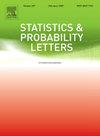西尔维斯特的β型分布问题
IF 0.7
4区 数学
Q3 STATISTICS & PROBABILITY
引用次数: 0
摘要
考虑Rd中的d+2个i.i.d随机点X1,…,Xd+2。在本文中,我们计算它们的凸包是一个单纯形的概率,关注三个特定的分布设置:•[(i)] X1的分布是多元标准正态分布。•[(ii)] X1的密度与单位球上的(1−‖x‖2)β (beta分布)成正比。•[(iii)] X1的密度与(1+‖x‖2)−β (beta素数分布)成正比。在高斯情况下,我们证明这个概率等于常规(d+1)维单纯形的立体角之和的两倍。本文章由计算机程序翻译,如有差异,请以英文原文为准。
Sylvester’s problem for beta-type distributions
Consider i.i.d. random points in . In this note, we compute the probability that their convex hull is a simplex focusing on three specific distributional settings:
- •[(i)] the distribution of is multivariate standard normal.
- •[(ii)] the density of is proportional to on the unit ball (the beta distribution).
- •[(iii)] the density of is proportional to (the beta prime distribution).
求助全文
通过发布文献求助,成功后即可免费获取论文全文。
去求助
来源期刊

Statistics & Probability Letters
数学-统计学与概率论
CiteScore
1.60
自引率
0.00%
发文量
173
审稿时长
6 months
期刊介绍:
Statistics & Probability Letters adopts a novel and highly innovative approach to the publication of research findings in statistics and probability. It features concise articles, rapid publication and broad coverage of the statistics and probability literature.
Statistics & Probability Letters is a refereed journal. Articles will be limited to six journal pages (13 double-space typed pages) including references and figures. Apart from the six-page limitation, originality, quality and clarity will be the criteria for choosing the material to be published in Statistics & Probability Letters. Every attempt will be made to provide the first review of a submitted manuscript within three months of submission.
The proliferation of literature and long publication delays have made it difficult for researchers and practitioners to keep up with new developments outside of, or even within, their specialization. The aim of Statistics & Probability Letters is to help to alleviate this problem. Concise communications (letters) allow readers to quickly and easily digest large amounts of material and to stay up-to-date with developments in all areas of statistics and probability.
The mainstream of Letters will focus on new statistical methods, theoretical results, and innovative applications of statistics and probability to other scientific disciplines. Key results and central ideas must be presented in a clear and concise manner. These results may be part of a larger study that the author will submit at a later time as a full length paper to SPL or to another journal. Theory and methodology may be published with proofs omitted, or only sketched, but only if sufficient support material is provided so that the findings can be verified. Empirical and computational results that are of significant value will be published.
 求助内容:
求助内容: 应助结果提醒方式:
应助结果提醒方式:


